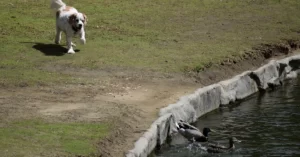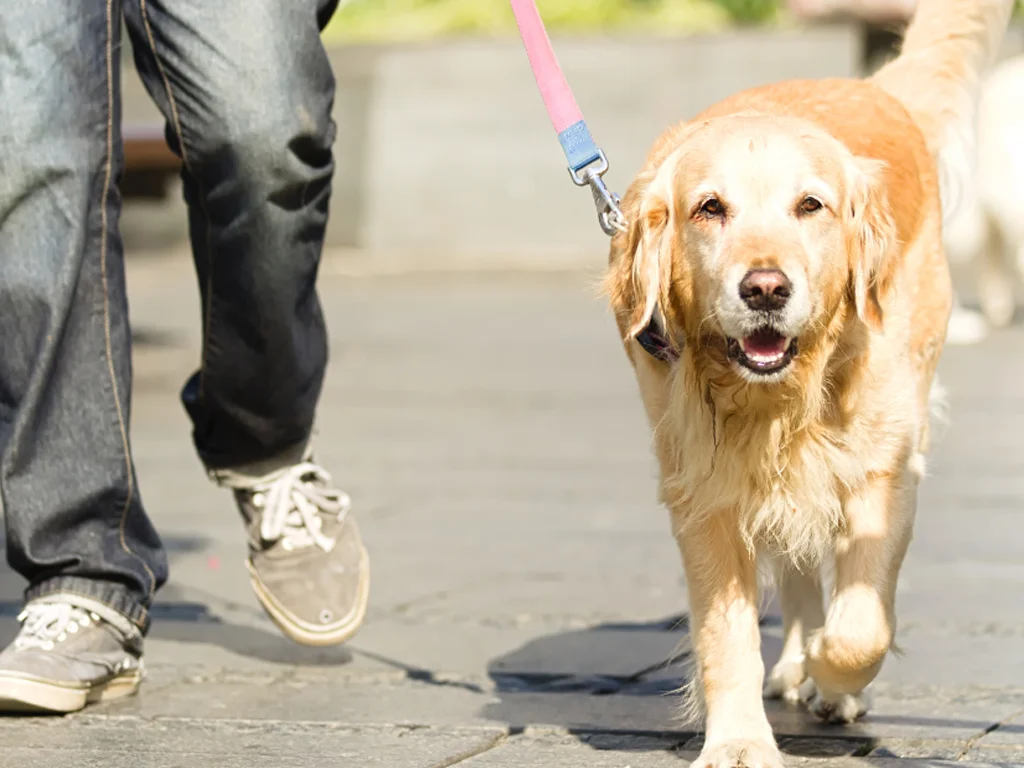Comprehensive Guide to Canine Impulse Control: Enhancing Your Dog’s Behaviour and Safety
 Understanding and nurturing impulse control in your dog is not just a part of responsible pet ownership; it’s a fundamental aspect of fostering a harmonious and safe living environment for both you and your dog. This comprehensive guide, packed with insights on Hamilton dog training and canine behaviour, delves deep into the essence of canine impulse control, blending expert knowledge with proven techniques. Join us on a detailed exploration of how to empower your dog with self-discipline, enhancing their quality of life and strengthening your bond.
Understanding and nurturing impulse control in your dog is not just a part of responsible pet ownership; it’s a fundamental aspect of fostering a harmonious and safe living environment for both you and your dog. This comprehensive guide, packed with insights on Hamilton dog training and canine behaviour, delves deep into the essence of canine impulse control, blending expert knowledge with proven techniques. Join us on a detailed exploration of how to empower your dog with self-discipline, enhancing their quality of life and strengthening your bond.
Unpacking Canine Impulse Control
In-Depth Understanding
 Impulse control in dogs, a crucial aspect of dog training, is akin to self-restraint in humans. It’s the ability to govern immediate responses to various stimuli, opting for a more measured reaction. Imagine a situation where your dog spots a squirrel during a walk down in downtown Hamilton. Without impulse control, their instinct might compel them to chase it, potentially leading to dangerous situations. Impulse control training teaches your dog to pause, assess, and react in a manner that is both safe and appropriate.
Impulse control in dogs, a crucial aspect of dog training, is akin to self-restraint in humans. It’s the ability to govern immediate responses to various stimuli, opting for a more measured reaction. Imagine a situation where your dog spots a squirrel during a walk down in downtown Hamilton. Without impulse control, their instinct might compel them to chase it, potentially leading to dangerous situations. Impulse control training teaches your dog to pause, assess, and react in a manner that is both safe and appropriate.
Key Components
- Self-Control:
- Resisting Natural Instincts: Training a dog in self-control, an essential part of positive reinforcement in dog training, involves teaching them to resist natural instincts and urges. This could include resisting the temptation to chase after a ball immediately or waiting patiently before eating their meal. It’s about instilling a level of discipline that overrides their instinctual reactions.
- Managing Excitement and Energy: Many dogs struggle with over-excitement or excessive energy, especially in stimulating environments. Developing self-control helps them manage these emotions and remain calm and collected, reducing the likelihood of erratic or hyperactive behaviour.
- Delayed Gratification:
- Understanding the Wait Command: A fundamental part of teaching delayed gratification is the ‘wait’ command. This instruction teaches dogs to pause before they act, whether it’s waiting for food, or a toy, or before crossing the street. It cultivates patience and helps the dog understand that good things come to those who wait.
- Building Tolerance: Gradually increasing the waiting period in training exercises helps build tolerance and patience in dogs. This practice, a key element of private dog training for impulse control, is crucial for situations where immediate action might lead to negative consequences, such as grabbing unsafe food or rushing towards a busy road.
- Focus:
- Maintaining Attention: Teaching a dog to maintain focus on their owner or a specific task amidst distractions is a critical aspect of impulse control. This ability is particularly important in busy or unfamiliar environments where a dog’s attention may be easily diverted.
- Distraction Training: Incorporating distractions in training sessions helps reinforce a dog’s ability to focus. This could involve practicing commands in a park where other animals are present or having family members move around during training exercises. The goal is to ensure that the dog learns to remain attentive and responsive despite external stimuli.
The Imperative of Canine Impulse Control
 Three Crucial Points
Three Crucial Points
- Safety Enhancement:
- Preventing Potential Hazards: A dog proficient in impulse control is significantly less likely to rush into potentially hazardous situations. For example, a well-trained dog won’t dart across a road in pursuit of a cat or squirrel, thereby avoiding possible accidents with oncoming traffic. This aspect of dog training is particularly crucial in urban environments where roads and traffic pose constant dangers.
- Interaction with Other Animals: Dogs that can control their impulses are less likely to engage in unpredictable or aggressive interactions with other animals. This control is vital in public spaces like parks, where encounters with other dogs and wildlife are frequent.
- Handling Distractions: A key component of impulse control training involves teaching dogs to maintain focus and obedience despite distractions. This skill is essential in ensuring your dog’s safety in various environments, whether it’s ignoring street noise or resisting the urge to chase birds during walks.
- Minimizing Accidents:
- Home Safety: In the home setting, dogs with poor impulse control might jump on furniture or guests, knock over items, or snatch food from tables. These behaviours not only create a chaotic environment but also pose risks of injury to both the dog and family members. Training your dog to control these impulses is crucial in maintaining a safe and orderly home.
- Public Etiquette: In public, dogs that lunge or jump on people can cause accidents or injuries, particularly to children, the elderly, or those with disabilities. Training your dog in impulse control is not just a matter of etiquette; it’s a responsibility to ensure the safety and comfort of others in the community.
- Preventing Resource Guarding: Dogs with impulse control issues may exhibit resource guarding behaviours, such as aggressively protecting their food or toys. This behaviour can lead to dangerous situations, especially if there are children or other pets in the home. Impulse control training helps mitigate these tendencies, promoting a safer cohabitation.
- Trainability:
- Foundation for Advanced Training: Dogs with a solid grounding in impulse control find it easier to learn and adhere to more complex commands. This trainability makes them more receptive to advanced training techniques, allowing for a broader range of learning opportunities and behaviours.
- Facilitating Socialisation: Impulse control is a vital component of socialisation training. Dogs that are well-disciplined are less likely to exhibit unruly behaviour in social settings, making interactions with other dogs and people more manageable and pleasant.
- Enhancing Communication: A dog that has been trained in impulse control has a better understanding of commands and expectations. This understanding fosters clearer communication between you and your dog, making training sessions more effective and efficient.
Benefits of Mastering Impulse Control in Your Dog
Enhancing Life Quality
- Deepening Human-Dog Relationships:
- Building Trust and Mutual Respect: A dog that has learned impulse control tends to have a stronger bond with its owner. This training requires consistent interaction, patience, and understanding, which in turn fosters a deep sense of trust and mutual respect. When a dog learns to look to its owner for cues, it demonstrates a level of trust that goes beyond basic obedience.
- Improved Communication: As dogs learn to control their impulses, they become more attuned to their owner’s commands and expectations. This improved communication makes it easier for owners to understand their dogs’ needs and behaviours, thereby enhancing the overall relationship.
- Behavioural Excellence:
- Adaptability in Various Situations: Dogs with strong impulse control are generally more adaptable to different environments and situations. Whether it’s a busy street, a crowded park, or a quiet home setting, these dogs can adjust their behaviour accordingly, making them more dependable and easier to manage.
- Reduced Behavioural Problems: Many common behavioural issues in dogs, such as excessive barking, jumping on people, and destructive chewing, stem from poor impulse control. By addressing this fundamental aspect, many of these problems can be mitigated or even eliminated.
- Psychological Well-being:
- Stress and Anxiety Reduction: Dogs that can effectively manage their impulses often exhibit lower levels of stress and anxiety. When a dog understands boundaries and expectations, it eliminates a lot of the confusion and frustration that can lead to stress-related behaviours.
- Creating a Sense of Security: Consistent training in impulse control provides dogs with a structured routine, which can be incredibly comforting to them. Knowing what to expect and how to behave in various situations can create a sense of security and well-being.
- Enhanced Safety Protocols:
- Preventing Accidents and Injuries: Dogs trained in impulse control are less likely to engage in behaviours that could lead to accidents or injuries. For example, a dog that doesn’t impulsively dash out the door or pull on the leash is less likely to encounter dangerous situations.
- Public Safety Consideration: Well-trained dogs contribute to public safety. They are less likely to cause harm or nuisance to other people and animals, making public spaces safer and more enjoyable for everyone.
Effective Training Techniques
Building Foundations
- Essential Commands: Start with basic commands like “sit,” “stay,” and “leave it.” These commands form the foundation of impulse control, teaching your dog to respond to your cues and resist immediate reactions.
- Focus and Patience Exercises: Incorporate waiting drills into everyday activities such as feeding. For instance, ask your dog to sit and wait before meals, gradually extending waiting times to improve concentration and patience.
- Reward-based Activities: Utilize treats and toys in exercises that compel your dog to pause and wait for your cue. This method reinforces the concept of delayed gratification and control.
- Walking Discipline: Train your dog to walk without pulling on the leash or becoming overly distracted during walks. This includes teaching them to ignore passing cars, people, and other animals.
- Structured Greetings: Train your dog to remain calm when meeting new people or animals. Teach them to sit and stay calmly before receiving affection or interacting with others.
- Routine Consistency: Habitual and uniform training across diverse settings amplifies the efficacy of impulse control exercises. Consistency in commands, rewards, and consequences helps your dog understand and adhere to expected behaviours.
- Positive Reinforcement Strategies: Focus on rewarding desirable behaviours rather than punishing undesirable ones. This positive approach encourages your dog to repeat good behaviours and fosters a positive learning environment.
How K9 Principles Enhance Impulse Control
Tailored Training Solutions

FAQs
-
A1. The sooner, the better. Starting with puppies is ideal, but older dogs can also learn effectively with patience and consistency.
Conclusion
Cultivating impulse control in your dog is a journey that requires commitment, patience, and the right training approach. By employing the techniques and insights from this guide, and seeking expert assistance from establishments like K9 Principles, you can significantly enhance your dog’s behaviour and safety. Remember, the path to a well-disciplined dog is paved with consistent training, understanding, and mutual respect. Embrace this rewarding journey and witness the transformation in your canine companion. Happy training!





